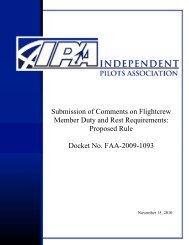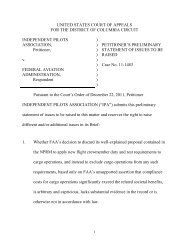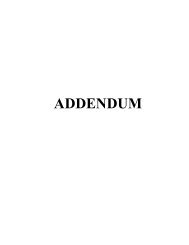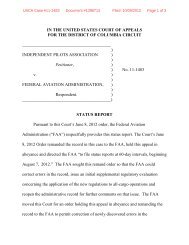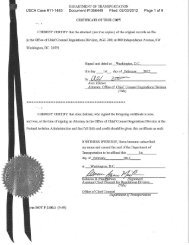Exhibits Vol 2 - Independent Pilots Association
Exhibits Vol 2 - Independent Pilots Association
Exhibits Vol 2 - Independent Pilots Association
You also want an ePaper? Increase the reach of your titles
YUMPU automatically turns print PDFs into web optimized ePapers that Google loves.
Downloaded from oem.bmj.com on December 21, 2012 - Published by group.bmj.com<br />
654 Williamson, Feyer<br />
accepted in many countries as incompatible<br />
with safe driving. The earliest eVects were seen<br />
for the Mackworth clock test and the latest for<br />
the dual task, although there was relatively little<br />
variation across tests. Longer periods of<br />
sleep deprivation were equivalent to higher<br />
alcohol doses for all tests except the grammatical<br />
reasoning and memory and search tasks.<br />
Equivalence with the BAC of 0.05% was also<br />
very similar within tests. Both parts of the dual<br />
task, either when tested alone, or in combination,<br />
showed equivalence at between 17 and 19<br />
hours of sleep loss corresponding in this study<br />
to between 2240 and 0050. For all measures of<br />
the Mackworth clock test, equivalence occurred<br />
after around 17 hours of sleep loss and<br />
for the symbol digit test after about 17–19<br />
hours without sleep.<br />
These results show that impairments in performance<br />
which have been judged as the legal<br />
limit for driving safely may start to occur as<br />
early as 17 hours after waking and around 18<br />
hours on average after waking. These results<br />
confirm earlier work on a single task. 9 It is<br />
important that these periods of wakefulness<br />
also correspond to the normal waking day for<br />
most people. In the community a 16–17 hour<br />
period of wakefulness would be regarded as<br />
normal, with bedtime typically occurring in the<br />
mid to late evening depending on the time of<br />
rising. It could be argued, therefore, that this<br />
common pattern of waking and sleeping plays a<br />
major part in ensuring safety. If the period of<br />
wakefulness is extended beyond the usual<br />
16–17 hours, performance is likely to be<br />
impaired suYciently to represent a considerably<br />
greater risk of injury. Driving home after a<br />
long work day, for example, may put you at<br />
increased risk of an accident. Drivers who have<br />
been awake for more than 17–18 hours are<br />
likely to be significantly slower at reacting and<br />
will be increasingly likely to miss information<br />
as the period of sleep loss increases even<br />
further.<br />
This study looked at eVects of sleep deprivation<br />
only under day worker conditions where<br />
subjects were rested after a reasonable number<br />
of hours sleep the night before. Although most<br />
people follow this sleep-waking regime, work<br />
schedules and lifestyle demands increasingly<br />
require people to extend their waking period<br />
for longer than 18 hours, shortening their<br />
sleeping period as a consequence, and to do so<br />
repeatedly over days, weeks, or even months.<br />
The eVects of such chronic partial sleep deprivation<br />
have not been considered by this study<br />
although these findings and a recent review of<br />
the literature 14 suggest that partial sleep deprivation<br />
may present very serious risk for safe<br />
performance.<br />
Although this study has not directly considered<br />
the role of circadian eVects, it is known<br />
that they interact with deficits in performance<br />
from continuous or partial sleep deprivation. 15<br />
This study was designed to only look at the<br />
eVects of sleep loss over a night without sleep<br />
after a day awake as this is the form that sleep<br />
loss often takes. This meant, however that the<br />
period of maximum sleep loss coincided with<br />
the time that circadian influences should have<br />
been greatest. As a result, performance deficits<br />
may have been higher for measures that were<br />
vulnerable to circadian influences so enhancing<br />
the apparent eVects of sleep loss. Further<br />
research is needed to clarify the relative eVects<br />
of sleep deprivation and circadian influences<br />
and to measure them against the alcohol comsumption<br />
benchmark. It is notable, however,<br />
that the deficits from sleep deprivation found<br />
here equivalent to a BAC of 0.05%, occurred<br />
between 2200 and 0000, which is well ahead of<br />
the time at which the circadian trough<br />
occurs. 15 16 This suggests that sleep deprivation<br />
and not circadian influences causes serious<br />
concern about decrements in performance,<br />
although our results show the additional deterioration<br />
in performance due to circadian<br />
eVects.<br />
The overall implications of the results of this<br />
study are clear. They show that the eVects on<br />
performance of moderate periods of being<br />
awake cannot be discounted. Sleep is needed<br />
after the end of a day if adverse eVects on performance<br />
are to be avoided. Most importantly,<br />
this study has allowed interpretation of these<br />
eVects on performance in terms of an accepted<br />
standard for safety. With a legal limit for alcohol<br />
use when driving as a standard, the results<br />
show that after 17–19 hours of wakefulness,<br />
subjects’ performance on many tests had<br />
dropped to that found at the legal limits for safe<br />
driving. Many people remain awake for periods<br />
of 16 hours or more for reasons of work, family,<br />
or social life. These results suggest that after<br />
this duration of wakefulness fatigue reaches a<br />
level that can compromise safe performance.<br />
The results also imply that many countries<br />
which set allowable BACs at the point that<br />
compromises safe performance should consider<br />
developing similar standards for fatigue to<br />
ensure that people who have had 18 hours or<br />
longer without sleep are kept from at risk<br />
behaviours such as driving, piloting aircraft, or<br />
operating machinery.<br />
We thank the subjects for their cooperation throughout the<br />
study. We also thank Rena Friswell and Samantha Finlay-Brown<br />
for their research assistance, Associate Professor Richard<br />
Mattick for assistance with alcohol administration and the staV<br />
of the National Drug and Alcohol Research Centre for permitting<br />
us to use their facilities. The project was funded by the<br />
Federal OYce of Road Safety.<br />
1 Horne J, Reyner LA. Sleep related vehicle accidents. BMJ<br />
1995;310:565–7.<br />
2 Sweatman PF, Ogden KJ, Haworth N, et al. NSW heavy<br />
vehicle crash study. Canberra: Federal OYce of Road Safety,<br />
1990.<br />
3 Leger D. The cost of sleep-related accidents: a report for the<br />
National Commission on Sleep Disorders Research. Sleep<br />
1994;17:84–93.<br />
4 Mitler M, Casakadon MA, Czeisler CA, et al. Catastrophes,<br />
sleep, and public policy: consensus report. Sleep 1988;11:<br />
100–9.<br />
5 Report on the National Commission on Sleep Disorders<br />
Research. Wake up America: a national sleep alert. Washington,<br />
DC: US Department of Health and Human Services,<br />
January 1993.<br />
6 Dement W C. The perils of drowsy driving. N Engl J Med<br />
1997;333:783–4.<br />
7 Committee on the benefits and costs of alternative federal<br />
blood alcohol concentration standards for commercial<br />
vehicle operators. Zero alcohol and other options: Limits for<br />
truck and bus drivers. Washington, DC: Transportation<br />
Research Board, 1987.<br />
8 Howat P, Sleet D, Smith I. Alcohol and driving: Is the<br />
0.05% blood alcohol concentration limit justified Drug<br />
and Alcohol Review 1991;10:151–66.<br />
9 Dawson A, Reid K. Fatigue, alcohol, and performance<br />
impairment. Nature 1997;388:235.<br />
www.occenvmed.com



